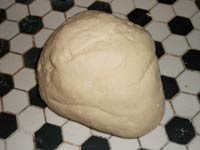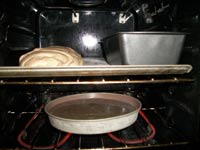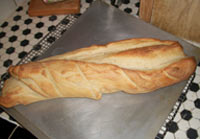Ooh la la - une baguette de pain francais! This bread is actually a variation of the basic white bread; it's pretty simple, but like the wheat bread, it takes rather a long time, most of which is just waiting for the dough to rise.
- 1 teaspoon active dry yeast
- 1 teaspoon sugar
- 1 1/2 cups warm water
- 4 to 4 1/2 cups unbleached all-purpose flour
- 2 1/2 teaspoons salt
- You will also need:
- a small spray bottle filled with water
Start by testing the yeast. Dissolve the sugar in the water, then add the yeast. Make sure that yeast bubbles! If not, grab another package of yeast and do it again.
Add two cups of the flour and mix til you've got a nice shaggy consistency (like the rug, not the Scooby Doo character). Add the other two cups of flour and mix until you have a less shaggy, more uniform dough.

Spread the remaining half cup of flour on the kneading surface, turn out the dough, and knead for eight to ten minutes, working in that extra flour until the dough is elastic, smooth, and resists the kneading a bit. It should not by any means be sticky.
Now the rising. It takes forever.
Place your lovely little dough ball in a deep, greased bowl, turning the dough so it's covered on all sides by the oil. Cover the bowl with plastic wrap and let it rise until doubled in size, which should be about one and a half to two hours. Repeat three to four times: the more you repeat the process, the more holes, the lighter your bread will be. Conversely, the less often you repeat the process, the denser your bread will be.
As it rises, you should notice holes appearing in the dough and the texture getting lighter.
After three or four rising cycles, split the dough into two pieces and shape into long loaves, about eighteen inches by three inches - the size is not so important. I've used this recipe to make one giant loaf as well as three smaller loaves. Just keep in mind: when you change the size, you change the baking time, so keep an eye on the bread as it bakes if you choose to change the loaf size.
Preheat the oven to 400 degrees and put the dough-loaves on a lightly greased baking sheet (or ungreased baking stone) and let rise for about 30 minutes.
Arrange the racks in the oven so that there's one rack as close to the bottom as possible and another rack in the middle of the oven. This is what the oven should look like:

After your bread's been rising for about 20 minutes, bring some water to a boil and place in a pan on the lowest rack while the water is still boiling. Be really careful here! I usually pull the rack out, place the pan on it, and pour the water in that way. Place the baking sheet in the oven as soon as possible afterwards. Grab your spray bottle and quickly spray the loaves and the sides of the oven liberally. Close the door, wait a minute or two, and repeat the spraying. Be sure you're not stingy with the water! Do this twice more, once after four minutes, the other after eight or so.

Bake for about 30 minutes. More accurate, I find, is to keep checking your bread until you see it is a beautiful golden brown. The true test: knock on the hard crust of the loaf. Hear a hollow, thumping sound? It's done!







